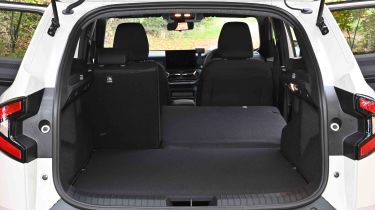Dacia Duster – Boot space, comfort & practicality
In terms of space per pound, the Duster offers more for your money than most rival SUVs

Interior and boot space are Duster strong points, especially given its still-modest exterior dimensions. A lofty driving position and low window line boost visibility, although rearward visibility isn’t as good as we’d like. The bonnet extends quite far out in front, but you can get a feel for the edges of the car, helping you to place the Duster on the road.
Dacia has also introduced what it calls YouClip. This is an attachment system which allows a variety of accessories to be secured in various places around the cabin, including beside the main infotainment display, on the back of the front seats and at the base of the centre console in the rear. Available kit includes a three-in-one accessory (£39) that combines a cup-holder, bag hook and LED torch. Smartphone and tablet holders, storage bags and hooks are among the other accessories, ranging from around £10-£40.
| Dimensions | |
| Length | 4,343mm |
| Width | 1,921mm |
| Height | 1,656mm |
| Number of seats | 5 |
| Boot space | 594-1,696 litres |
Dimensions and size
The Duster uses a platform that’s shared with a supermini, but the Dacia feels spacious inside. The current Duster is slightly longer and wider than the old model at 4,343mm long, 1,921mm wide and 1,656mm tall. It isn’t quite as tall as it was before, but it still has a height advantage over the likes of the Skoda Kamiq.
How practical is the Dacia Duster?
Seats & space in the front
A wide range of adjustment for both the seat and the steering wheel makes it easy for Duster drivers of all sizes to find a comfortable seating position. You will need the top-of-the-range Extreme trim to get adjustable lumbar support for the driver, though. Meanwhile Expression trim and above include a sliding armrest, improving comfort on longer journeys and providing additional storage. The small rear window and rear side windows limit over-the-shoulder visibility somewhat, but at least the door mirrors are large.
Seats & space in the back
While the Duster doesn’t feel any more posh in the back, space is a strong point. Headroom is very impressive in particular, with our measurements putting it ahead of similarly priced rivals such as the MG ZS and very close to larger family SUVs such as the Kia Sportage. Kneeroom is competitive, too, while the soft seats feel comfortable – even for a third passenger in the fairly wide, flat middle seat. There’s loads of foot room beneath the front seats, and only a small centre hump in the floor.
The ISOFIX points are accessible behind zipped covers, which makes them a little more fiddly to get to than in rival cars. The door bins in the back are tiny, too.
Boot space
Boot capacity varies based on the Duster’s powertrain. A battery beneath the boot floor means that the Hybrid model offers 430 litres of volume compared with the petrol’s 517 litres. This extra volume is gained below a false floor, so in every version there’s a large area with which to play – it’s just that the Bi-Fuel petrol model’s has greater depth.
A high boot lip makes it a little tricky to load heavy items on board, but the rear seat backs drop almost completely level with the boot floor, so items slide in easily.
Towing
Engine choice also affects the Duster’s towing capacity. The hybrid is the least capable in this department, with a maximum towing capacity of 750kg. If you’ve got things to haul, the TCe 130 engine in either front or four-wheel-drive guise can pull up to 1,500kg.







